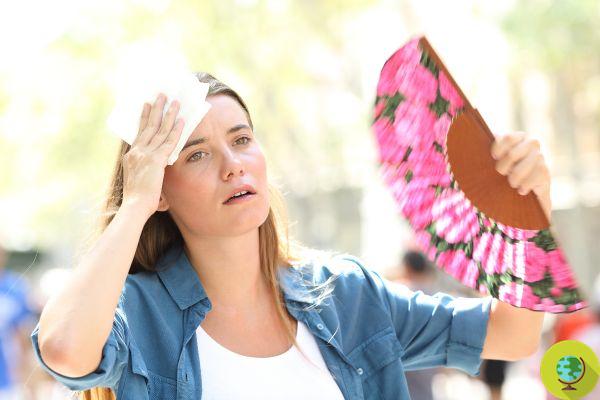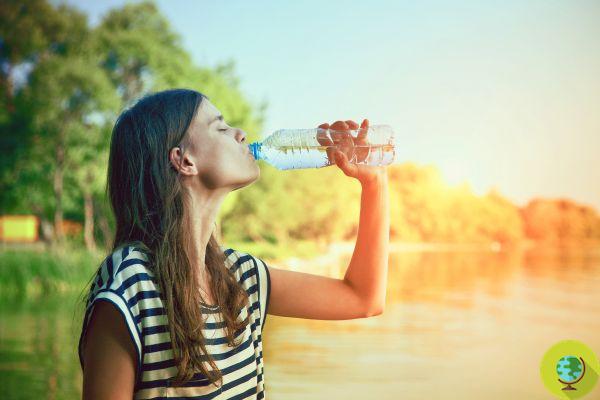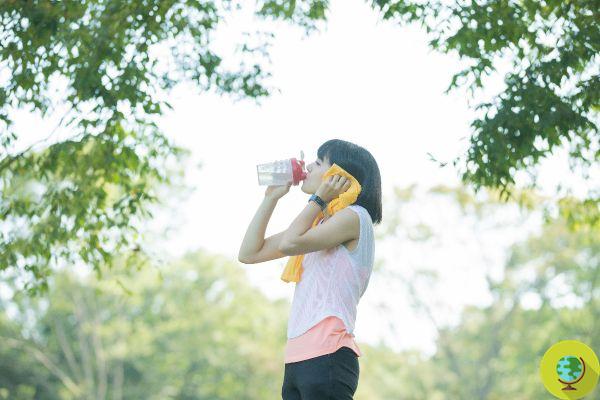What is the difference between heat stroke and sunstroke? What are the symptoms, how to prevent them and when to see your doctor
Il heat stroke andinsolation are diseases caused by exposure to extreme temperatures. Left untreated, sunstroke can develop into heatstroke, which can be life-threatening.
According to the Centers for Disease Control and Prevention (CDC), above-average temperatures or unusually humid weather kill more than 600 people in the United States each year.
As temperatures rise, it is important to know how to avoid heat-related illnesses. Let's see all the symptoms and treatments of heatstroke and sunstroke.

@Antonio Guillem / 123rf
Index
Heat stroke and insolation: what they are and differences
These conditions both derive from the overexposure to extremely hot climatic conditions. However, heat stroke alone can cause severe damage to the body. (Read also: Record heat: in case of heat stroke, do not give paracetamol or acetylsalicylic acid)
Heat stroke
Il heat stroke, also called sunstroke, is the most serious disease linked to overexposure to the sun. It occurs when the body temperature is 40 ° or higher.
If not treated immediately, heatstroke can damage multiple organs and more, including:
- brain and nervous system
- circulatory system
- lungs
- liver
- Reindeer
- digestive tract
- muscles
Insolation
THEinsolation it is less severe than heatstroke. Anyone who suspects that they have sunstroke should immediately rest and rehydrate. If symptoms do not improve, see a doctor to prevent heat stroke. (Read also: Sunburns: Here are the natural remedies that really work)
There are two types of heatstroke: exertional and non-exertional
Il non-exertional heat stroke it occurs in those who fail to adapt well to increasingly warm temperatures. The elderly, people with chronic illnesses and children are often affected.
A person typically experiences this type of heatstroke when they are indoors without air conditioning, and may not be engaging in any physical activity. It can take several days of high temperatures for effortless heatstroke to occur, and it's common during extreme heatwaves.
Il exertional heat stroke it occurs, however, in people whose bodies can no longer adapt to rising temperatures during exercise or work. This condition can develop within hours, and it usually affects people who spend time outdoors.
Spending time in closed cars puts young children and pets at high risk for heatstroke. The CDC estimates that when the outdoor temperature is 27 °, the temperature inside a closed car rises to 42 ° within 20 minutes. The hotter it is outside, the faster the temperature rises inside a vehicle. (Read also: 10 golden rules to fight heat and heat stroke)

@Ivan Kruk / 123rf
Symptoms of heat stroke
I symptoms of sunstroke and heat stroke they can develop rapidly or over several days. They can cause significant discomfort, and often occur first with muscle cramps.
Insolation can lead to:
- muscle cramps
- a fast, weak heartbeat
- a general sense of weakness
- nausea or vomiting
- excessive sweating
- cold and clammy skin
- dizziness and sometimes fainting
- dark-colored urine
- headache
Symptoms of insolation
Heatstroke can start with the same symptoms as sunstroke. It can be life-threatening, and symptoms can worsen quickly, including:
- a temperature of 40 ° or higher
- hot and dry skin
- a very fast heartbeat
- confusion
- restlessness
- bias
- convulsions
- loss of consciousness
- coma

@123rf/123rf
Treatment
Anyone who suspects they have sunstroke should immediately take measures, such as:
- move to a shady place
- remove one or more items of clothing
- get away from the sun
- turn on a fan or air conditioning
- run cool water over the skin or apply fresh, wet towels to the body
- drinking liquids such as water and sports drinks
If a person vomits or feels nauseous, a doctor's consultation is required.
(Read also: Afa: the 10 best drinks to quench thirst and rehydrate the body)
When to go to a doctor
Anyone suffering from symptoms of heat stroke should consult a doctor. Six symptoms worsen or do not improve within 1 hour, seek immediate medical attention. A doctor will likely be able to diagnose heat-related illness based on symptoms. They may also perform tests to check for potential complications.
For example, a doctor can tell if there are:
- muscle damage
- dehydration, often with a urine sample or blood test
- heart and lung damage, possibly using imaging
- problems with the circulatory system
- a lack of kidney or liver function
In case of symptoms of heat stroke the doctor can:
- apply ice packs to the neck, armpits and groin
- spray fresh mists
- support any damaged organ systems
- use a specialized cooling blanket
- administer intravenous fluids that promote cooling and hydration
Risk factors
Some factors can make one person more prone to heat stroke and sunstroke. These include:
- being overweight or obese
- have a significant disability
- have a sunburn
- be under 13 or over 65
- use certain medications for heart problems or high blood pressure, especially diuretics
- experiencing sudden changes in temperature, for example when traveling from a cold to a warm climate
- spending time outdoors in extreme heat or indoors without a way to cool off
Prevention
When temperatures rise, it is important to know how prevent heat-related diseases. The goal is to keep the body cool.
Here are some useful tips:
- stay indoors during the hottest hours of the day
- try to stay in the shade when outdoors
- drink 2-4 extra glasses of water every hour while exposed to high temperatures
- take frequent breaks when working or exercising outdoors on hot days
- wear loose, light-colored clothing
- use cooler water for showers and baths
- wear a hat with a wide brim to protect your face from the sun
- avoid drinks that dehydrate, including those with caffeine or alcohol
- wear breathable fabrics such as cotton rather than synthetics
- spend part of the day in an air-conditioned place, such as a shopping mall, library, or cinema
No one should be left alone in a parked car in very hot weather; this could be particularly dangerous for children and people aged 65 and over.
With proper and timely treatment, a person can fully recover from heat-related diseases. Recognizing the symptoms of sunstroke and taking steps to cool the body can prevent the condition from turning into heatstroke.
If left untreated, heat stroke can cause serious complications and lead to death. Even on the hottest days, these diseases can generally be prevented by taking proper precautions.
Could it be interesting for you:
- 7 eco-sustainable moves to face the summer heat
- Afa: how to fight the heat in 8 moves excluding air conditioning
- 10 foods and drinks to prepare at home to cool down
- Going to the sea and being close to the water makes us happy: that's why
- Dogs and hot asphalt don't get along: how to protect their paws in hot weather


























